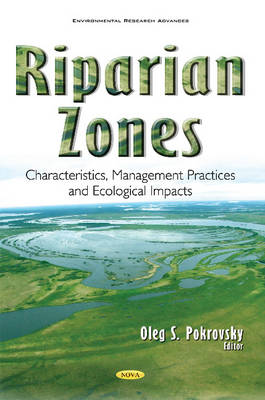26%OFF

Stock image for illustration purposes only - book cover, edition or condition may vary.
Riparian Zones: Characteristics, Management Practices & Ecological Impacts
Oleg S. Pokrovsky (Ed.)
€ 281.55
€ 208.88
FREE Delivery in Ireland
Description for Riparian Zones: Characteristics, Management Practices & Ecological Impacts
Hardback. Editor(s): Pokrovsky, Oleg S. Num Pages: 380 pages, illustrations. BIC Classification: PSAF; RNF. Category: (P) Professional & Vocational; (UP) Postgraduate, Research & Scholarly; (UU) Undergraduate. Dimension: 185 x 261 x 27. Weight in Grams: 846.
Riparian ecosystems occur in semi-terrestrial areas adjacent to water bodies and are influenced by freshwater. Riparian wetlands are defined as land areas adjacent to perennial, intermittent, and ephemeral streams, lakes or rivers. As a result, these areas have high water tables and periodic flooding. They support a wide range of wetland vegetation including emergent macrophytes, grasses and trees. Riparian zones and wetlands are among the most vulnerable natural ecosystems to both climate change and human impact, and they are likely to represent important hot spots for climate change adaptation. The riparian ecosystems, located at the interface between water and land, are extremely dynamic environments in terms of structure, function, diversity and strength of abiotic-biotic feedbacks. Nowadays, the riparian wetlands are strongly affected by both global climate change and human activity. For these reasons, there is a steady and even abrupt increase of scientific publications linked to riparian problems. A web search of riparian as a topic yielded more than 16,000 papers published between 1950 and 2015, with 7,000 of them have been published over the past five years and 10,500 produced over the preceding sixty years. This rise of scientific interest is, however, strongly biased geographically. A search of riparian in the titles of 4,773 scientific publications (1950-2015) yields high geographical bias with papers studying all aspects of riparian zones in the United States, Brazil, China, Canada, Africa and Europe, respectively, and only one in Russia. This book is intended to partially fill this gap by presenting nine chapters describing the studies of riparian and flood plain zones of Russia. The fourteen chapters of the book, written by the experts in the field of landscape geography, biogeochemistry, GIS techniques and biology cover two of the most important riparian zones of the world: the Amazon varzea and the Ob/Irtysh floodplains. A multidisciplinary approach across wide geographical scales and various techniques presented in this book will be interesting for a large community of scholars, students, and researchers from academic and private organisations.
Product Details
Format
Hardback
Publication date
2016
Publisher
Nova Science Publishers Inc
Condition
New
Number of Pages
380
Place of Publication
New York, United States
ISBN
9781634846134
SKU
V9781634846134
Shipping Time
Usually ships in 5 to 9 working days
Ref
99-2
About Oleg S. Pokrovsky (Ed.)
Oleg S Pokrovsky graduated from Geochemistry department, Moscow State University, PhD in geochemistry (1994), entered CNRS (FRANCE) in 1999 and works over past decade on biogeochemistry of arctic and subarctic rivers and lakes. He is now a research director at the CNRS (FRANCE). He possesses both experimental physico-chemical, microbiological and geochemical expertise. Over past decade, O S Pokrovsky directed and co-directed 12 PhD students, 5 Post-doctoral research associates. Since 2000, O S Pokrovsky coordinated and leaded more than 20 various research grants, international cooperation programs and consortia, large-scale national (French) grants and served as important partner of a number of European (FP7) projects. Since 2013, O S Pokrovsky, a recipient of a prestigious Mega-grant of Russian Ministry of Science and Education (3 M $ for 3 years), directs BIO-GEO-CLIM Laboratory on Environment, Climate and Permafrost at Tomsk State University. O S Pokrovsky has strong academic records with ~160 papers peer reviewed papers and the same number of conference abstracts published since 1992 on physical chemistry, experimental geochemistry, and aquatic biogeochemistry; his HI factor is equal to 35 and the total citation number is close to 4000.
Reviews for Riparian Zones: Characteristics, Management Practices & Ecological Impacts
